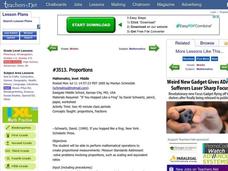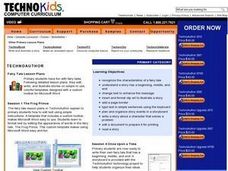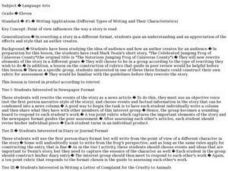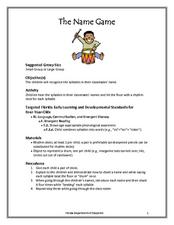Apple State University
Friendly Letter Mini-Lesson
This mini-lesson about informal letter writing is packed with a lot of information about writing a friendly letter. Class members begin by working in pairs to answer questions after reviewing letter models. Then, take part in a grand...
Curated OER
Guided Reading using Gail Gibbon's book Frogs
Students read to locate information about the stages of a frog's life and organize on a chart.
National Science Teachers Association
Hop into Action
Young scientists find out what makes amphibians such unique and interesting animals in this simple life science activity. After looking at pictures and discussing the characteristics of amphibians, learners complete a series of three...
Curated OER
The Magical World of Russian Fairy Tales
Students read several fairy tales of Russian origin. They brainstorm common elements of a fairy tale and identify those elements in several examples. They retell a favorite fairy tale through a skit, oral storytelling, a sketch, or a...
Curated OER
Brown Bear, Brown Bear, What Do You See?
Learners read the story Brown Bear, Brown Bear, What Do You See? and read companion poems, make a bear book, blend sounds, and more. For this guided reading lesson plan, pupils take 5 days to read the book.
Curated OER
Guided Reading "In the Night Sky"
Students participate in a variety of reading exercises, such as choral reading and reading response journal, to reinforce concepts about space and nocturnal animals.
Curated OER
Problem and Solution Lesson
Students explore problems and solutions in literature. In this literature lesson, students identify problems and solutions in short guided and independent reading samples. Students also discuss characterization techniques used to develop...
Curated OER
Kate and the Beanstalk Lesson Plan
Students read the story Kate and the Beanstalk in order to compare and contrast this fractured tale to the original fairy tale of Jack and the Beanstalk. In this fairy tale reading lesson plan, students first discuss the plots of many...
Curated OER
Segmenting and Blending with Word Families
Students sound out CVC words. In this literacy instructional activity, the teacher guides students through the process of sounding out three-letter words with a as the middle vowel using both repetition and movement. Then students...
Curated OER
Scientists Breed See-Through Frogs
Learners participate in a pre-reading activity, then read a news article about the breeding of transparent frogs. In this biology and current events lesson plan, the teacher introduces the article with a question and a vocabulary...
Curated OER
Scientists Discover Giant Frog Fossil
Students examine a world map and read a news article about the discovery of a giant frog fossil. In this earth science and current event lesson plan, the teacher introduces an article with a discussion about continental drift and a...
Curated OER
Cool Melons Turn to Frogs
Third graders become familiar with the poetry of Issa. In this haiku instructional activity, 3rd graders recognize the format of a haiku and learn about the life of Issa (the poet) through focused questions, vocabulary and reading...
Curated OER
Five Little Frogs
Students use music to study concepts in math. In this music math lesson, students sing songs, read books, and learn counting skills in frog themed activities.
Curated OER
Science Summaries are the Bomb!
Fifth graders read a dissection article and complete close reading activities for the text. For this reading skills lesson, 5th graders read an interactive frog dissection article in teams. Student teams complete a KWL chart and write a...
Curated OER
Proportions
Middle schoolers perform mathematical operations to create proportional measurements, after listening to the David Schwartz book, If You Hopped Like a Frog.
Curated OER
Techno Author
Here is a great way to explore language arts by completing a computer activity with classmates. Youngsters read a fairy tale in class and analyze where the beginning, middle and end are. They create their own story using clip art and...
Curated OER
Exploring Figurative Language in Fiction and Nonfiction
A reading of Pat Street's There's a Frog in My Throat launches a study of figurative language. Using a pocket chart, display one phrase containing figurative language. Class members choose the best explanation from three choices offered....
Curated OER
Rooster's Off to See the World
Young learners listen to the book Rooster's Off to See the World, and complete simple math activities using the book. In this simple math lesson, students read and list the animals in the book. They arrange animal picture squares using...
Curated OER
Life Cycles
Third graders investigate the stages of animal life cycles. They examine an egg and compare it to an inanimate object, read a booklet about the life cycle and define key vocabulary terms, and observe a mealworm. Students then design a...
Curated OER
Writing Applications: Different Types of Writing and Their Characteristics
Twelfth graders rewrite a story in a different format to understand the effects of the author's style. In this writing style instructional activity, 12th graders read Mark Twain's "The Celebrated Jumping Frog of Calaveras County" and...
Curated OER
Analyzing Character Traits
Students read "Frog and Toad are Friends" and investigate physical, emotional, and mental character traits. They brainstorm a list of character traits that make a good friend. The list is placed into a visual ranking system that is...
Curated OER
Sensational Summarizers
Students study strategies that aid comprehension. They focus on the main ideas of a passage and eliminate unnecessary and repetitive information. They substitute super ordinate terms for a list of items and create a topic sentence.
Curated OER
Ready, Set, Summarize
Students summarize nonfiction text. After reviewing the correct way to read in order to summarize, students independently read a nonfiction article. They write a summary paragraph using the three step-process outlined by the instructor...
Curated OER
The Name Game
Students identify animals and their babies. In this animal name instructional activity, students come up with other animals whose babies have the same name. Students use the names of animals and their babies to write poems.

























